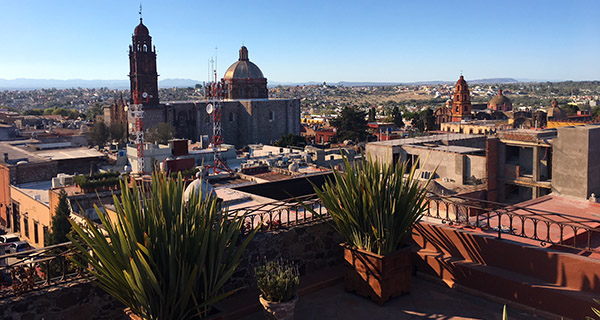 I’ve just returned from San Miguel de Allende full of interesting new experiences gathered in a 475-year-old Mexican central highlands town renowned worldwide for its hospitality to culturally creative folk.
I’ve just returned from San Miguel de Allende full of interesting new experiences gathered in a 475-year-old Mexican central highlands town renowned worldwide for its hospitality to culturally creative folk.
Those visitors like to rent 300-year-old casas, practise speaking Spanish and participate in a nuanced cosmopolitan life. The local media refer to this phenomenon as “retirement tourism.”
Strolling the cobblestone streets on an early-morning visit to a pasteleria, you’re quickly aware of many other 60-and-70-something North Americans (and possible Europeans), who are relatively fit, and often dressed in hip combinations of colour and informality.
Friendly calls of “Hola!” are exchanged as we pass en route to fresh coffee, magical almond cakes and morning social gatherings with San Miguel amigos.
A cultural UNESCO World Heritage Site designated in 2008, San Miguel de Allende (often known as SMA) now has about 160,000 residents, of whom over 10,000 are expats. Increasing numbers of cultural tourists arrive for short visits but many expats choose to live there for up to six months a year.
They live in casas they’ve bought from Mexican residents or stay in one of about 4,000 residences that are offered by online services like Airbnb. Many of these come with a small staff of cook and household helper, and even a gardener. Monthly residency might start at US$2,700 to US$3,000 for one or two bedrooms, and it’s possible to spend up to US$10,000 a month for a large old casa with four bedrooms and staff.
Ideally, two (or more) friendly couples split the costs, which are substantially cheaper than equivalent numbers of hotel nights.
Many retirement tourists now choose to spend their entire winters in San Miguel.
Virtually every night of the week it’s possible to attend lectures, seminars and art shows that embrace local talent, visiting lecturers, and talented musicians and dancers. During the day, there are art institutes and gallery locations like the Fabrica La Aurora (a repurposed 1902 textile factory) to visit and a magnificent botanical garden. And the El Centro district combines a real Mexican mercado (marketplace), galleries, restaurants, and a magnificent public garden.
San Miguel is not a beach resort – it’s located 2,000 metres above sea level. And you see very few runners speeding about its high-altitude cobbled streets. While a youthful contingent of visitors (largely parties from Mexico City, 274 kilometres to the south) appears for weddings on the weekends, the majority of the tourists you see are of the baby boomer generation.
Plainly, the boomers are in a community they love, doing things they feel are important. When you meet them at parties in their casas, they love to expound on their reasons for being in SMA.
Chief of these is the pleasure of being with like-minded souls, celebrating art and literature in an Old World town high in the New World sierras.
The local cast is varied and changing, and notably well-educated. This trip I met a retired Canadian ambassador, an international furniture company CEO, several retired Washington, D.C., lawyers, a retired Harvard psychiatrist, and Mexican architects, painters and writers.
Perhaps most intriguing were the Senior Nomads, “Living life and loving each other one Airbnb at a time,” according to their website. Debbie and Michael Campbell are 63 and 73, and have just found SMA. Their story takes retirement tourism to an entirely new level.
Six years ago, they sold their businesses and home in Seattle, cast off their worldly possessions and began to travel to their heart’s content. Their recent book, Your Keys, Our Home, describes their first five years of retired nomadism, becoming Airbnb’s biggest client, travelling to over 50 countries around the world.
They have three core living costs: air travel, Airbnb fees and health insurance. They report average global nightly accommodation as US$90, holding constant since 2013.
Essentially, they’re circling the globe while their health holds and the stock market is kind to their investments. They have four adult children whose Seattle, Los Angeles and Paris family homes they stop at occasionally. But essentially they’re on a free rein.
While they’re not typical SMA types, it’s typical that you’d meet them there.
So as we contemplate our retirements, let’s not assume that means staying home in Canada – or even having a home. The tourism potential of retirement is broad, only limited by your investments and stomach for risk. Why not go for it?
Troy Media columnist Mike Robinson has been CEO of three Canadian NGOs: the Arctic Institute of North America, the Glenbow Museum and the Bill Reid Gallery.
The views, opinions and positions expressed by columnists and contributors are the author’s alone. They do not inherently or expressly reflect the views, opinions and/or positions of our publication.






